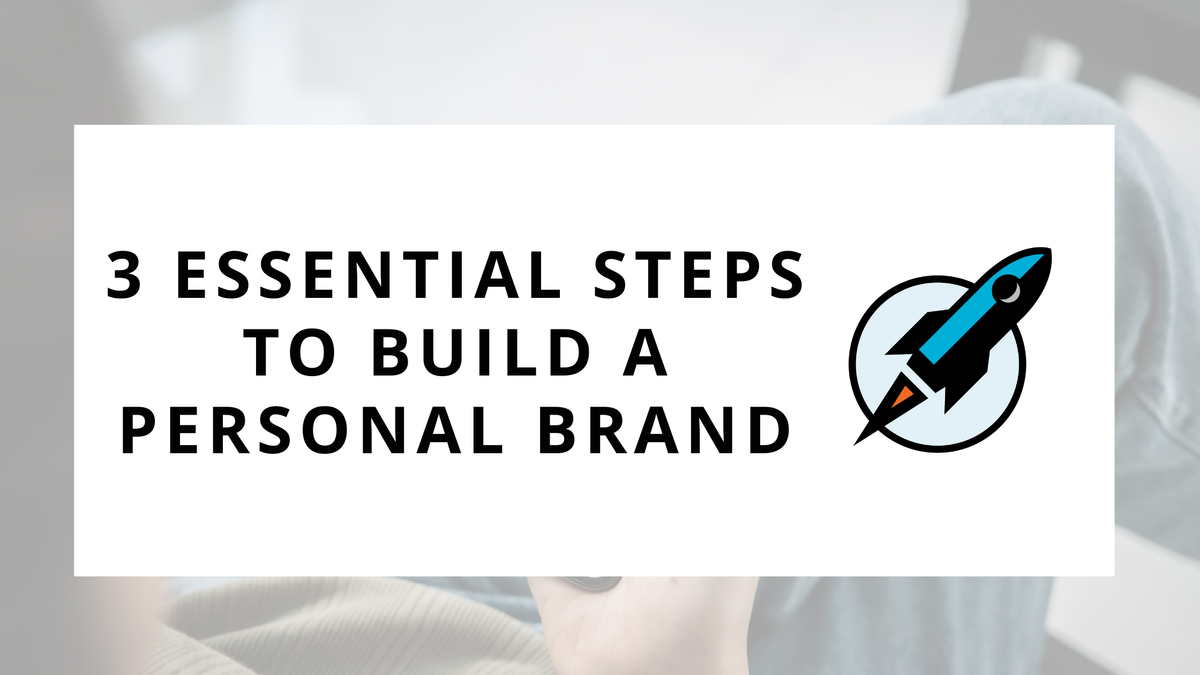3 Essential Steps to Build a Personal Brand

As we kickstart the new year, it’s a great time to reflect on your personal brand.
How are you positioning yourself in the marketplace?
More importantly, how do you position yourself in your relationships and professional network?
This is an important topic to consider. Your personal brand enables you to be effective in the digital world. It’s the underpinning of building authenticity, establishing credibility, and clarifying the value you deliver.
In other words, your personal brand is a valuable asset.
In this week’s Sell with Social, we’re going to dive into the topic of personal branding in more detail. We’ll review what a personal brand is and how you can create and implement one for yourself.
Why You NEED a Personal Brand
Imagine walking into a room of people, and everyone there already knows your name and what you do. They trust that you are an expert in your field and have already received value from you through the content you’ve created.
What would that do to your career? How would that enable you to be more successful?
This is what having a strong personal brand does. It’s a point of leverage that enables you to create authentic relationships, expand your reach, and position yourself as an expert.
In today's digital world, personal branding isn't just a buzzword—it's a necessity. There are direct benefits to building your brand.
- Building Trust: Forbes reports that 92% of people trust recommendations from individuals (even if they don’t know them) over brands. A strong personal brand fosters trust and credibility, making you a more appealing choice for hiring managers, clients, and collaborators.
- Networking Growth: LinkedIn data shows that individuals with strong personal brands can attract up to 15 times more opportunities than those without. Your personal brand can open doors to new offers, collaborations, and networking opportunities that might otherwise be out of reach.
- Clarity of Purpose: Personal branding allows you to control the narrative around your professional life. You can proactively manage how you are perceived online, which is especially important in a world of rapid change.
Most importantly - Your personal brand is a professional asset you own and control.
The reputation and reach you build through your personal brand is an asset you can leverage in any position you find yourself in. Whether that’s helping you sell more products for your employer, running your own business, or simply trying to make a more significant impact in your professional life.
Step 1 - Define Your Brand
Let’s now talk about how you can start to create your personal brand.
As I discussed in my post on Company Brand vs Personal Brand, the simple definition of a brand is that it is a promise.
Your brand is a promise to your audience that you will consistently deliver. This promise is conveyed through various means, including visual elements like logos and slogans, as well as actions taken and the content produced.
When it comes to your personal brand, I want you to define what your promise is. What do you do? How do you do it? And what can your audience gain from it?
Here’s my brand promise - "I promise to transform sales and marketing professionals into trusted authorities in their field. Through creating educational content online, I empower them to expand their reach, build authority, and increase their revenue."
Distill your message with a simple 1-3 sentence statement that clearly identifies your brand promise.
And don’t worry… your personal brand promise doesn’t have to be set in stone. It can and should evolve alongside you as you grow.
Step 2 - Implement Your Brand
Once you’ve defined your brand, it’s time to implement it.
This means making it clear to your audience what you promise to deliver. Whether in-person, online, or through your content, you need to update your “personal brand collateral." Below are a few spots I’d recommend:
In Your Elevator Pitch - I’d start by creating an “elevator pitch” for yourself. This is how you answer the question, “So, what do you do?” Your elevator pitch should be similar to your brand’s promise, but more direct in explaining what you do.
On Your Profiles - You’ll want to update your online profiles across various platforms to reflect your personal brand promise. Ensure that all of the high visibility spots directly communicate your personal brand. In each spot, ask yourself, “Does this reflect my brand’s promise?”
- Profile Picture
- Headlines
- About Section
- Experience Section
- Featured Content
In The Mirror - Arguably, the most important spot to implement your brand is in the mirror. YOU need to commit to your brand’s promise. YOU give your brand value. This means the fulfillment of your brand is 100% a result of you believing in yourself. This isn’t just self-help talk; it’s the only way.
Step 3 - Live Your Brand
Now, it’s time to deliver on that promise.
The value of your brand will increase each time you consistently deliver on what you’ve said you will do. This enables you to expand your reach, build trust, and increase the value of your brand.
Here are ten examples of ways to deliver value through your brand:
- Networking and Collaboration: Engage actively with your professional community. Attend industry events, participate in webinars, or join professional groups. Collaboration with others in your field can amplify your brand.
- Consistency in Decision Making: Ensure your choices and actions align with your brand's values and promises. This consistency helps solidify your brand in the minds of your audience.
- Public Speaking and Presentations: Seize opportunities for public speaking or presenting at conferences and seminars. This showcases your expertise and reinforces your brand's message.
- Content Creation: Share your expertise through blogs or articles. This can position you as a thought leader in your field. Ensure your writing style and topics consistently align with your brand.
- Social Media Activity: Use social media platforms to share insights, comment on industry trends, and engage with your audience. Tailor your content to reflect your personal brand's voice and values.
- Sharing Knowledge: Offer valuable information, tips, or insights that benefit your audience. This could be through workshops, webinars, or online courses.
- Mentoring and Coaching: Providing guidance or mentorship to others in your industry not only adds value but also strengthens your reputation as an expert and leader.
- Community Involvement: Participate in community events or volunteer for causes that align with your brand. This demonstrates commitment to your values and contributes to a positive social impact.
- Continuous Learning: Stay updated with the latest trends and skills in your field. This commitment to growth shows that your brand is dynamic and evolving.
- Personal Projects: Engage in projects or hobbies that reflect your brand's ethos. This could be anything from a creative side project to starting a niche interest group.
The key here is to commit to fulfilling your brand’s promise in the actions you take. The more aligned you are with your brand, the more valuable your brand will become to your audience.
The Path to A Trusted Brand
A personal brand built on authenticity not only attracts attention but also builds trust. When people trust you, they're more likely to engage with your content, recommend you to others, and offer opportunities. This trust is not built overnight; it's earned through consistent, authentic representation of your brand.
Building a personal brand is a journey of discovering and sharing your unique blend of skills, experiences, and personality. It's about making a mark in your professional field and creating connections based on trust and authenticity.
So, where will your personal branding journey take you? Whether you're just starting or looking to refine your existing brand, now is the time to start shaping the story you want the world to hear.

For this week’s action items, I want you to consider your personal brand.
Following the outline above, start to become intentional with how you are building your personal brand. Begin to take advantage of all the benefits that come with becoming a trusted authority in your industry.
Here are the steps to take:
- Define Your Brand Promise - Write down your brand promise in 1-3 sentences. What will you deliver consistently to your target audience?
- Implement Your Brand - Review all of the "collateral" of your personal brand (headshots, profiles, bios, featured content, etc.) and ensure that they align with the brand you’re creating.
- Live Your Brand - Then deliver, deliver, deliver. Follow through with your brand’s promise by providing value to your audience. Make a plan to consistently show up and take action in alignment with your brand.
And if you want more help related to personal branding, check out the Catalyst Community. We’re focusing our January group content and discussions on the topic of personal brands.
